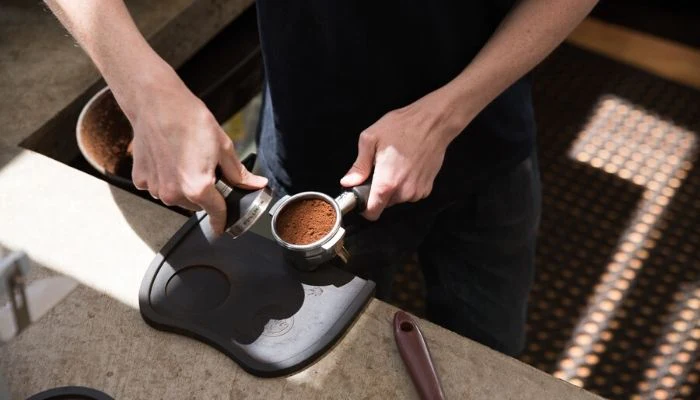You finally dialed in perfectly ground coffee ready for pulling espresso shots. But before locking that portafilter into the machine, comes the make-or-break tamping step. This precise downward press of grounds aims for ideal density allowing water to extract out flavors completely in its short vertical journey. Press too softly, and water races straight through. Crank up psi force excessively, and you choke flow completely. In this post we talk about How Hard To Tamp Espresso.
Somewhere lies optimal tamping pressure – not too light, not too mighty. Let’s analyze exact recommended tamp strength ranges today’s barista experts advise to master cafe-quality espresso brewing. Learn how to gauge perfect pressure levels through calibrated bathroom scales, dispelling myths around needing Herculean brute force.
Why Tamping Develops The Espresso Foundation
Before understanding ideal tamp parameters, it helps to know why tamping after grinding remains so vital in the first place. This step, while appearing simple, executes quite a delicate chemistry behind channeling water correctly.
When grinding beans into fluffy grounds, they pile loosely into the portafilter basket, leaving huge gaps for water to race through rapidly. Uneven densities mean water follows paths of least resistance around denser areas causing channeling instead of evenly saturating all grounds to extract total flavors.
Here’s where tamping works its magic:
1. Eliminates Air Pockets – compresses grounds into an even cake
2. Slows Flow – enhances extraction increasing contact time with grounds
3. Builds Resistance & Pressure – develops desirable crema foam at surface
But apply too little pressure, you under extract with fast thin streams. Overdo it and water can’t penetrate tightly at all – bitters, blonding, etc. Time to refine that pressure for goldilocks density!
Calibrating Tamp Force
Novice baristas often assume achieving an epic 30+ lb force tamp feels intuitively necessary from watching theatrical cafe flourishes. But the latest science shows no advantage extracting past 15-20 lb for most grind sizes. Still, gauging exact pressure gets tricky. Here’s how to remove guesswork:
1. Bathroom Scale Method
Use a small scale under your tamping mat to develop feel for precise ranges in lbs force applied. Start lighter, progress heavier while pulling test shots to pinpoint ideal sweet spot.
2. Nickel Coin Test
Visually check tamp evenness using a US nickel test. If any grounds peek out around edges post-tamp, generally means you have packed too lightly.
3. Extract Visual Cues
Optimal 25-30 second shot times pulling 1:2 ratios and thicker tiger striping prove you’ve set up appropriate resistance levels.
Finding Your Flair
While calibrated bathroom scales build early tamping confidence in correct pressure zones, don’t become a slave to them forever! Eventually graduate to “feeling” that flawless tamp harmonizing grounds, machine, and your individually crafted flavor. Let experience guide your ideal strength like making the perfect handshake – not too soft, not too bone crushing!
Advanced Tamping Techniques
Once mastering basic even, centered pressure across the portafilter, try working in some leverage moves:
1. Tamp With Twists
Helps grind any stray clumps while packing uniformly.
2. Tamp Then Lift and Retamp
Redistributes density across all grounds.
3. Tamp While Nutating
Rotating wrist in circles evens out your tamping strength across to minimize channeling opportunities. Each area receives focused downward force.
Regardless of extra moves, keep that pressure in check! Remember too heavy-handed risks damaging equipment or your wrists long term. Not to mention bitterness ruining all your hard grinding work sourcing incredible beans.
The Takeaway: Level Up Your Tamp Gradually
While freestyle flair minus scales builds confidence over time, start by quantifying and honing tamp pressure between 15 to 20 pounds of force. Prioritize even distributions across the basket, adjust grind size accordingly to harmonize resistance, and remain open to improving your technique. There’s beauty in learning, gradual progress, and simply enjoying life’s flavors along the way. “I hope this How Hard To Tamp Espresso” post helps you.

